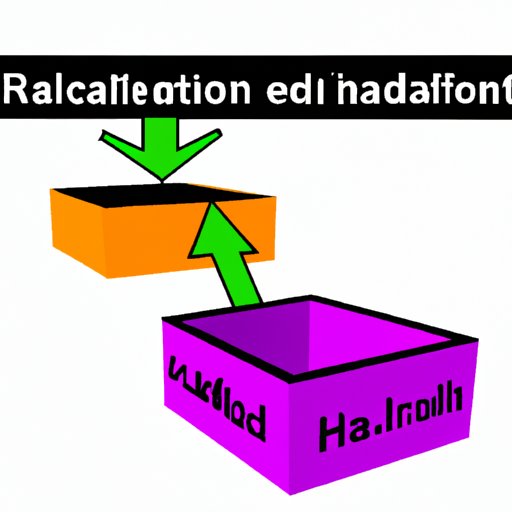
I. Introduction
Half-life is a term that often comes up in discussions of radioactivity, but it also has applications beyond just nuclear physics. Understanding the concept of half-life can help us comprehend natural processes, benefitting fields from medicine to archaeology. In this article, we’ll discuss how to calculate half-life and its importance in different industries.
II. Explaining the Concept of Half-Life in Simple Terms
Half-life is the time it takes for half of the atoms in a sample of a radioactive substance to decay. It’s a measure of the rate of decay and can be calculated using a mathematical formula.
Everyday items like bananas, used smoke detectors, and carbon dating rely on half-life. The bananas are naturally slightly radioactive, normally with a half-life of 1.2 billion years, so they are not harmful, but they do set off radiation alarms at ports. Smoke detectors contain small amounts of certain radioactive substances and detect smoke by measuring changes in radiation. Carbon dating gives us an approximate age of ancient fossils by measuring the ratio of carbon-14 to carbon-12, with a half-life of 5,700 years.
In nuclear medicine, half-life plays a crucial role. Radioactive isotopes are commonly used to diagnose and treat diseases like cancer. A medical professional must precisely calculate dosages and the half-life of the isotopes to minimize risk. Additionally, scientists use half-life to estimate how long nuclear waste must be stored to become safe enough for the environment.
III. Providing Step-by-Step Instructions
For calculating half-life, you have to use the mathematical formula A =A0(1/2)t/t1/2. It relates to A, the amount of a sample you have left after time t. A0 is the initial amount of the sample, and t1/2 is the half-life of the substance.
The tools required for calculating speed are a calculator with exponential functions. Input A values after a given time has passed and A0 values for when time is zero.
Here’s how:
- Input the values for A and A0.
- Divide both sides of the equation by A0.
- Apply logarithms to both sides.
- Divide both sides by the common factor and find the value of t.
- Check the answer with significant figures accuracy.
The easiest way to calculate half-life is to input the numbers into an online half-life calculator.
Examples of situations where half-life calculations are used include carbon dating, nuclear medicine, and nuclear power plant maintenance. For instance, technicians monitor the half-life of radioactive isotopes used in nuclear power to prevent disasters and understand how long it takes for isotopes to decay harmlessly.
IV. Real-world Applications
Half-life is essential in many fields of work, like healthcare and archaeology. For example, in healthcare, doctors use various radioactive isotopes to perform diagnostics. In cancer treatments, they calculate dosages based on how long it will take for half the radioactive material to leave the body. In other treatments, they calculate the half-life of the radioactive particle to make sure it stays active long enough to perform its intended purpose.
In archaeology, determining the half-life of organic objects allows scientists to estimate their age. The carbon dating technique analyses fossils’ carbon-14 to carbon-12 ratios, quickening the half-life calculation process instead of waiting billions of years to check the element’s decay. Knowing the half-life of a substance gives scientists a powerful tool to age older matter accurately.
Additionally, half-life is used in environmental science and nuclear power plant procedures. Nuclear power plant engineers rely on half-life calculations to understand the extent of exposure employees have to nuclear materials. In nuclear waste management, scientists calculate the half-life of radionuclides to decide how long waste needs to be stored before it’s not harmful to people or the environment.
V. Comparing and Contrasting Half-Life to Other Related Concepts
Half-life isn’t the only concept to look at when considering radioactive decay phenomena. Decay constant is another concept that represents the probability of radioactive decay occurring per unit of time, whereas half-life measures the time it takes for half of the atoms to decay.
Another popular concept is the rate of decay. It represents how fast a sample of a radioactive substance will decay, depending on its initial and current conditions. In contrast, half-life provides a fixed point in time to compare older samples to newer ones to gauge how much the decay rate has changed.
For instance, imagine a 5-milligram sample of radioactive iron with a half-life of 7.2 redials disintegrates down to 1.25 milligrams over 200 seconds. The decay constant would represent how often the atoms are disintegrating within those 200 seconds, whereas the half-life tells us how much the atoms should disintegrate over 200 seconds.
VI. Combining It with Visual Aids
Half-life calculations can be challenging to visualize. Still, with clear graphics and interactive calculators that allow readers to work out half-life examples themselves, it becomes clear and easy to understand. Providers can find various resources on websites like The Physics Classroom to make the learning experience more engaging.
Visual aids like diagrams, graphs, and videos help readers comprehend complex concepts, and interactive tools like half-life calculators let them practice and reinforce those skills. For example, interactives like PhET Interactive Simulations offer a broad array of tools for physics students to investigate radioactive decay in the safety of their own home. Instructors can supplement the lesson with hands-on activities to enhance students’ experience and build their skills.
VII. Conclusion
Calculating half-life is crucial in understanding natural processes like carbon dating, nuclear medicine, and nuclear power plants. While half-life often comes up in physics and engineering, its principles are crucial because they solve everyday problems. With this step-by-step guide on how to calculate half-life and its various applications, you have valuable tools for life, along with an understanding of mathematical principles. Whether you’re a Stargate fan, an undergraduate in physics, or a doctor, this guide has everything you need to know about half-life. You can learn more on various external resources or explore visual aids and interactive tools to help you understand this crucial concept better.




